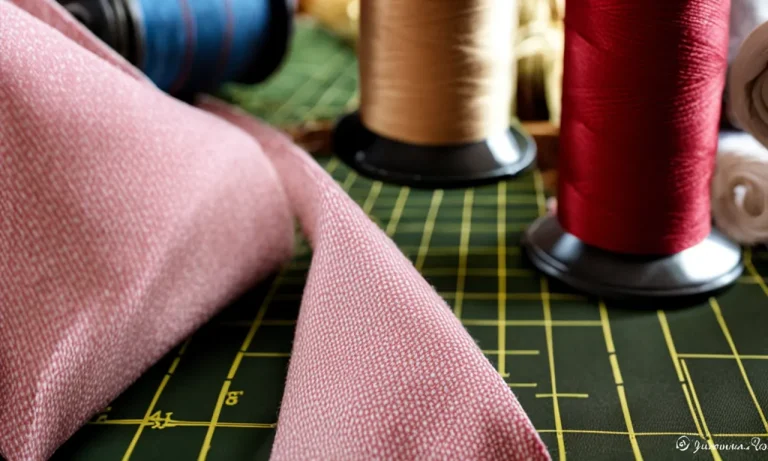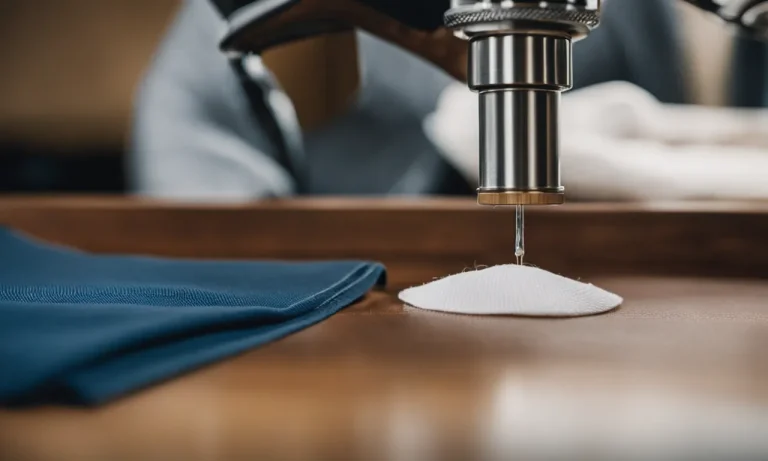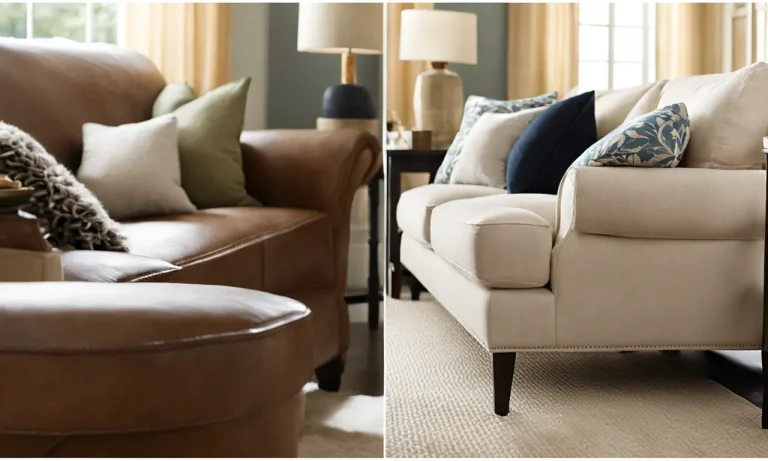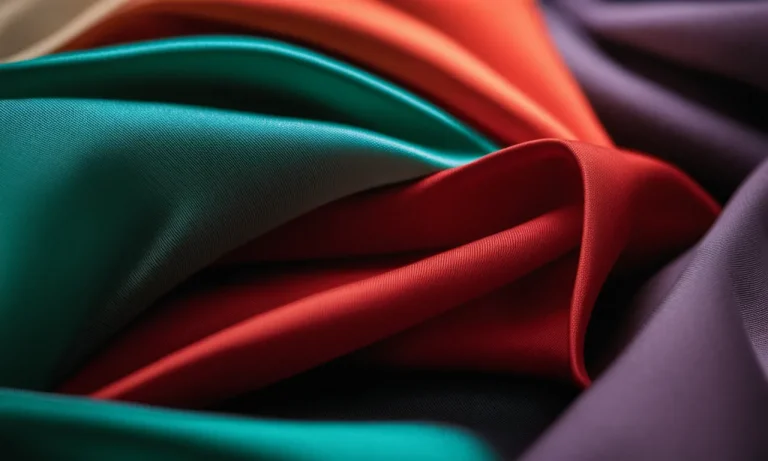Is Rayon A Good Fabric? A Detailed Look At The Pros And Cons
Rayon is a semi-synthetic fabric that has become increasingly popular in recent years for clothing and other textile products. With its soft texture and affordable price point, rayon may seem like an ideal fabric. But is rayon truly a good fabric choice?
The answer is more complex than a simple yes or no.
If you’re short on time, here’s a quick answer to your question: Rayon has benefits like its softness, low cost, and versatility but also downsides like its lack of durability and potential environmental impact during production.
Ultimately, whether rayon is “good” depends on your priorities and needs.
In this approximately 3,000 word article, we’ll take an in-depth look at the pros and cons of rayon. We’ll cover characteristics like its appearance, cost, environmental impact, durability, and more. We’ll also compare rayon to other common fabrics like cotton and polyester.
Read on for a comprehensive overview of rayon fabric so you can decide if it’s a good choice for your needs.
What is Rayon?
Rayon is a versatile fabric that is commonly used in the fashion industry. It is known for its softness, drapability, and ability to mimic the look and feel of natural fibers like silk, cotton, and linen. Rayon is made from cellulose fibers derived from wood pulp or other plant-based materials.
It is considered a semi-synthetic fabric because it is created through a chemical process involving the conversion of natural materials into a usable textile.
Brief history of rayon
The history of rayon dates back to the late 19th century when it was first developed as an alternative to silk. In 1884, French chemist Hilaire de Chardonnet invented the first commercially successful form of rayon, which he called “artificial silk.”
This early version of rayon was made from nitrocellulose, a highly flammable material. Over the years, advancements in technology led to the development of safer and more durable forms of rayon.
How rayon is made
Rayon is made through a process called “regeneration,” which involves chemically treating cellulose fibers to create a viscous liquid. This liquid is then extruded through spinnerets to form long, continuous filaments.
These filaments are then spun into yarns, which can be woven or knitted into fabrics. The specific method of manufacturing rayon can vary depending on the type of rayon being produced.
Types of rayon
There are several types of rayon, each with its own unique properties and characteristics. The most common types of rayon include:
- Viscose rayon: This is the most widely produced type of rayon. It is known for its softness, breathability, and ability to absorb moisture.
- Modal rayon: Modal rayon is a type of rayon that is made from beech trees. It is known for its softness, strength, and ability to retain color.
- Lyocell rayon: Lyocell rayon, also known as Tencel, is a type of rayon that is made from wood pulp. It is known for its durability, breathability, and eco-friendly production process.
Appearance and Texture of Rayon
Rayon is a versatile fabric that offers a unique combination of appearance and texture. Its characteristics make it a popular choice for many clothing items and home furnishings. Let’s take a closer look at some of the key factors that contribute to the appeal of rayon.
Drape and Softness
One of the standout features of rayon is its exceptional drape and softness. The fabric has a fluidity that allows it to gracefully hang and move. This makes it ideal for flowing garments such as dresses, skirts, and blouses.
Rayon’s softness adds to its comfort, making it pleasant to wear against the skin. It has a lightweight feel that can be perfect for warm weather or layering.
Ability to Mimic Other Fabrics
Rayon has the remarkable ability to mimic the appearance and texture of other fabrics. It can imitate silk, cotton, linen, and even wool. This versatility allows designers to create affordable alternatives to expensive fabrics.
With rayon, you can enjoy the look and feel of luxurious materials without breaking the bank. Whether you desire the elegance of silk or the casual vibe of cotton, rayon can deliver.
Wrinkling
While rayon has many positive attributes, it does have a tendency to wrinkle. This is something to consider, especially if you prefer low-maintenance clothing. However, with proper care and handling, you can minimize the wrinkling issue.
It is recommended to gently iron or steam your rayon garments to restore their smoothness. Additionally, choosing blends or treated versions of rayon can help reduce wrinkling.
Did you know? According to a study conducted by the Textile Association of America, rayon is one of the most widely used fabrics in the fashion industry, accounting for approximately 15% of all clothing materials used.
Cost and Availability of Rayon
Affordability compared to natural fibers
One of the major advantages of rayon is its affordability compared to natural fibers. Rayon is often considered a cost-effective alternative to fabrics like silk and cotton. While natural fibers can be quite expensive due to factors such as production costs and limited availability, rayon offers a more budget-friendly option for consumers.
This makes it a great choice for individuals who want to enjoy the benefits of a luxurious fabric without breaking the bank.
According to a study conducted by Textile World, the average price per yard of rayon fabric is significantly lower than that of silk or cotton. This makes rayon an attractive option for those who are looking for quality fabric at a more affordable price point.
Wide availability
Rayon is widely available in the market, making it easily accessible to consumers. Whether you are shopping online or visiting a local store, you are likely to find a wide range of rayon fabrics to choose from.
This availability ensures that you can easily find the right type and design of rayon fabric for your specific needs.
According to a report by Fibre2Fashion, rayon is one of the most commonly produced and used fabrics worldwide. Its popularity is attributed to its versatility, which allows it to be used in various industries, including fashion, home furnishings, and textiles.
With such widespread use, it is no surprise that rayon is readily available in the market, making it a convenient choice for consumers.
Durability of Rayon
When it comes to evaluating the durability of fabrics, rayon has both its strengths and weaknesses. Let’s take a closer look at some key factors:
Pilling susceptibility
One of the concerns often associated with rayon is its propensity to pill. Pilling refers to the formation of small, fuzzy balls on the surface of the fabric, which can make it look worn out and less appealing.
While rayon can be susceptible to pilling, it’s important to note that this can vary depending on the quality of the fabric and how it is cared for. Regularly laundering rayon garments according to the manufacturer’s instructions and avoiding harsh detergents can help minimize pilling.
Colorfastness
Colorfastness refers to a fabric’s ability to retain its color without fading or bleeding. In this aspect, rayon generally performs well. It has good color retention properties and can maintain its vibrant hues for an extended period of time.
However, it’s worth noting that some dyes used in rayon production may be less colorfast than others. Therefore, it’s always a good idea to test a small, inconspicuous area of the fabric before exposing it to water or other cleaning agents.
Strength when wet
Rayon is known to lose some of its strength when wet. It can become weaker and more prone to stretching or tearing when exposed to moisture. This characteristic is important to keep in mind when laundering rayon garments.
It is best to hand wash or use a gentle cycle in a garment bag to minimize the risk of damage. Additionally, avoid wringing out wet rayon garments as this can further weaken the fabric.
Sustainability and Environmental Impact
Production process harms environment
The production process of rayon, although widely used and appreciated for its versatility, does have some negative impacts on the environment. The most common type of rayon, known as viscose rayon, is made from wood pulp, which is chemically treated to create fibers.
This chemical treatment involves the use of hazardous substances such as carbon disulfide, which can be harmful to human health and the environment.
The production of rayon also requires a significant amount of water and energy. The chemicals used in the process can pollute water sources if not properly managed, and the energy consumption contributes to carbon emissions and climate change.
However, it is worth noting that efforts are being made to reduce the environmental impact of rayon production. Some manufacturers are adopting more sustainable practices, such as using closed-loop systems that recycle water and chemicals, and sourcing wood pulp from responsibly managed forests.
Biodegradability and recyclability
One positive aspect of rayon is its biodegradability. Unlike synthetic fibers like polyester, rayon is derived from natural materials and can break down naturally over time. This means that when disposed of properly, rayon can return to the environment without leaving behind harmful pollutants.
Moreover, rayon can also be recycled. While the process of recycling rayon can be complex, it is possible to convert old rayon garments into new fibers. This helps to reduce waste and extend the lifespan of the fabric.
It is important to note that the sustainability and environmental impact of rayon can vary depending on the specific manufacturing processes and practices employed by different companies. To make informed choices, consumers are encouraged to look for rayon products that are certified by reputable organizations, such as the Forest Stewardship Council (FSC) or the Global Organic Textile Standard (GOTS), which ensure responsible sourcing and production practices.
For more information on the environmental impact of rayon and sustainable fashion, you can visit websites like Greenpeace or Fashion Revolution.
Rayon vs. Similar Fabrics (Cotton, Polyester)
Rayon vs. Cotton
When comparing rayon to cotton, there are several factors to consider. Rayon is a semi-synthetic fabric made from wood pulp, while cotton is a natural fiber derived from the cotton plant. Both fabrics have their own unique advantages and disadvantages.
One of the main differences between rayon and cotton is their breathability. Cotton is known for its excellent breathability, allowing air to flow easily through the fabric. This makes cotton a great choice for warm weather or for people who tend to sweat a lot.
On the other hand, rayon can be less breathable and may trap heat, making it less suitable for hot climates.
Another aspect to consider is the softness of the fabric. Rayon has a silky texture and drapes beautifully, giving it a luxurious feel. Cotton, on the other hand, is known for its softness and comfort against the skin.
It is often preferred for sensitive skin or for those who prioritize comfort over other factors.
When it comes to durability, cotton tends to be more sturdy and long-lasting than rayon. Cotton can withstand frequent washing and is less prone to tearing or pilling. Rayon, on the other hand, can be more delicate and may require special care to maintain its quality.
In terms of price, cotton is generally more affordable than rayon. This is because cotton is a widely available natural fiber, while rayon requires a more complex manufacturing process.
Rayon vs. Polyester
When comparing rayon to polyester, it’s important to note that both fabrics are synthetic but have different properties and uses.
One of the main differences between rayon and polyester is their moisture-wicking abilities. Polyester is known for its moisture-wicking properties, meaning it can quickly absorb and evaporate moisture from the skin. This makes polyester a popular choice for athletic wear and outdoor activities.
Rayon, on the other hand, does not have the same moisture-wicking properties and may feel less comfortable during physical activities.
In terms of durability, polyester is known for its strength and resistance to wrinkles, shrinking, and fading. It is a highly durable fabric that can withstand frequent washing and intense wear. Rayon, on the other hand, can be more delicate and may require gentle care to avoid damage.
When it comes to breathability, rayon is generally more breathable than polyester. Rayon has a natural ability to absorb and release moisture, allowing air to flow through the fabric. Polyester, on the other hand, is less breathable and may trap heat, making it less suitable for hot climates.
Another aspect to consider is the price. Polyester is generally more affordable than rayon, making it a popular choice for budget-conscious consumers.
Conclusion
Rayon has some benefits like its soft drape, low cost, and versatility. But there are also significant downsides like its lack of durability when wet, negative environmental impact of production, and tendency to shrink and pill.
While rayon works well for certain uses like blouses and dresses, for products needing more strength and longevity, natural fibers like cotton and wool or synthetics like polyester may be better choices. The pros and cons of rayon depend largely on your specific needs and preferences.
At the end of the day, rayon is a fabric with both advantages and disadvantages. While it may be a worthwhile choice for some low-cost clothing items where delicacy and softness are priorities, rayon likely falls short for durable everyday fabrics.
By understanding the complete profile of rayon’s characteristics, you can determine if it is a good fabric choice for your particular purposes.







